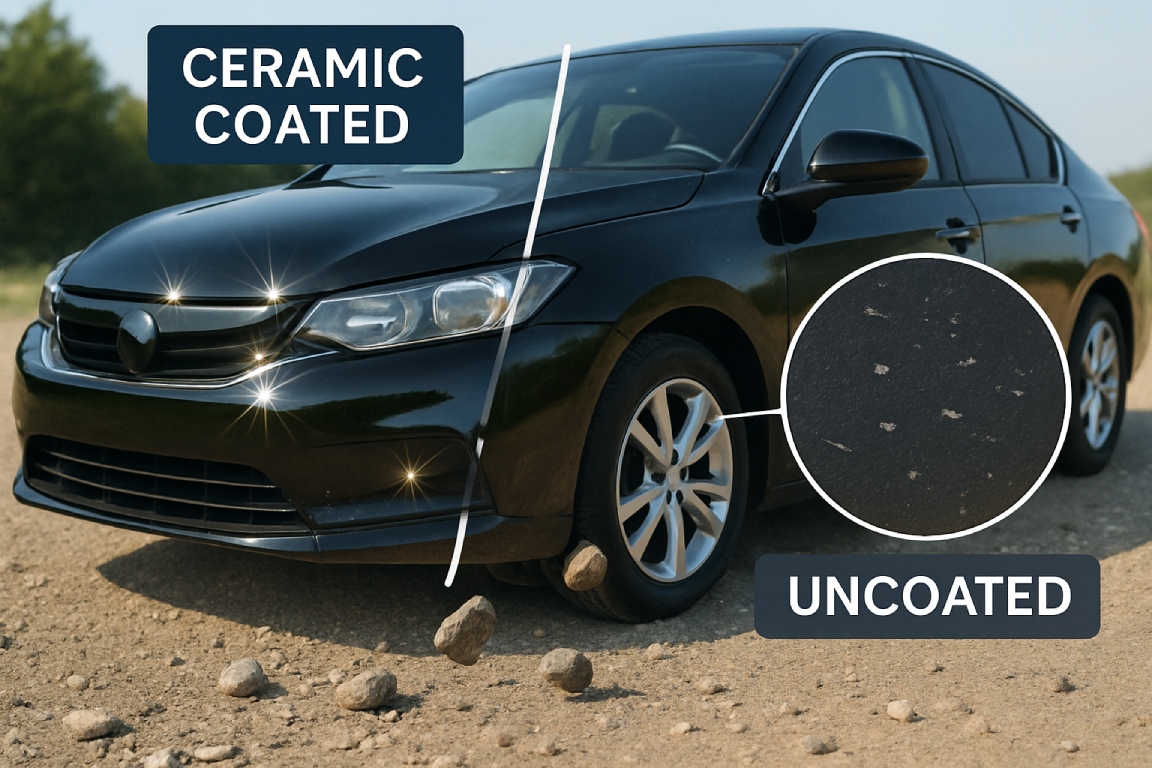Curious if ceramic coating protects against rock chips? While it’s a fantastic shield for your car’s paint against UV rays, chemical etching, and environmental contaminants, it won’t stand up to physical impacts. Its thin, hard layer—often just 0.5 to 2 microns thick—lacks the flexibility to absorb energy from high-velocity debris like rocks. Instead, the force transfers to the paint, causing chips. Stick around to explore stronger protective options for your vehicle.
Key Takeaways
- Ceramic coating does not effectively protect against rock chips due to its thin, brittle layer.
- It excels in chemical and UV protection, not physical impact resistance.
- Rock impacts can crack ceramic coating, exposing underlying paint to damage.
- Paint Protection Film (PPF) is recommended for superior defense against rock chips.
- Combining PPF with ceramic coating offers enhanced overall vehicle protection.
Understanding Ceramic Coating Basics
A ceramic coating is a liquid polymer solution that you apply to your vehicle’s exterior to form a protective layer.
It chemically bonds to the factory paint using nanotechnology, where tiny particles penetrate microscopic imperfections, creating a hard, glass-like shield.
Ceramic coatings bond to paint through nanotechnology, with tiny particles filling imperfections to form a durable, glass-like protective shield.
Composed primarily of Silicon Dioxide (SiO2), it may include Titanium Dioxide (TiO2) and resins like Polydimethylsiloxanes (PDMs) for structure and thermal stability. Unlike traditional wax, ceramic coatings offer long-term protection that can last up to 5 years, providing superior durability against environmental damage.
You’ll notice its hydrophobic nature as water beads and rolls off, alongside an enhanced, mirror-like gloss and slick surface from filled pores.
This coating can achieve a hardness rating of up to 9H hardness rating, offering resistance against minor scratches and blemishes.
Application demands precision—wash, decontaminate, and polish the surface first.
Apply it by hand in small sections with a microfiber pad, respect dwell times, and allow proper curing in a controlled environment for ideal bonding.
Protective Strengths of Ceramic Coatings
While ceramic coatings offer an impressive shield for your vehicle, their protective strengths extend across multiple dimensions critical to maintaining paint integrity.
You’ll notice their hydrophobic properties repel water, making dirt and grime slide off effortlessly, so cleaning’s a breeze.
They also guard against chemical etching from bird droppings, tree sap, and acid rain, preserving your paint’s finish when you act quickly.
Moreover, ceramic coatings block up to 99% of harmful UV rays, preventing oxidation and fading, keeping your car’s color vibrant.
They enhance gloss, delivering a mirror-like shine that boosts aesthetics.
With a hard, durable layer, they outlast waxes, resisting minor scratches and swirl marks from washing, ensuring your vehicle stays pristine for years.
Additionally, ceramic coatings provide heat resistance, protecting your car’s exterior from high temperatures and preventing paint softening or deterioration.
Similar to RV roof coatings, they deliver long-term durability against environmental wear.
Limitations Against Rock Chip Damage
As you evaluate ceramic coatings for rock chip protection, understand that their thin layer—often just microns thick—offers minimal defense against high-velocity impacts.
You’ll notice that these coatings lack the flexibility to absorb energy, transferring the force of a rock strike directly to the underlying paint or clear coat.
This impact absorption deficiency means you can’t rely on them to prevent chips, despite their hardness and other protective benefits.
Additionally, while ceramic coatings enhance surface durability, they do not provide a physical barrier against the direct impact of debris like rocks.
Thin Layer Vulnerability
How effective is ceramic coating when it comes to shielding your vehicle from rock chips?
Frankly, it’s quite limited due to its thin layer vulnerability.
You’re working with a coating that’s only 0.5 to 2 microns thick—sometimes up to 5 microns in premium products—compared to your car’s clear coat at 35-50 microns.
This microscopic layer, while hard with ratings like 9H, offers minimal resistance to physical impacts from stones or gravel.
It might slightly buffer tiny debris, reducing minor chipping, but it’s brittle and can’t stop larger or high-velocity projectiles from damaging your paint.
Unlike thicker paint protection film at 200 microns, ceramic coating isn’t built for this.
It excels instead at chemical and UV protection, not rock chip defense.
Additionally, the average thickness of ceramic coatings, ranging between 0.5 to 1 μm, highlights their inadequacy against significant physical damage like rock chips.
Impact Absorption Deficiency
Why does ceramic coating fall short in protecting your car from rock chips? It’s not built for impact absorption. You’re dealing with a coating that’s microns thin, designed for chemical and UV resistance, not to cushion high-velocity impacts. UV protection waxes, commonly used on fiberglass surfaces, provide similar environmental defenses but also fail to offer any real impact resistance.
Its hardness—rated up to 10H—resists minor scratches but translates to brittleness, lacking the elasticity to flex under force.
Moreover, it can’t dissipate energy effectively. When a rock strikes, the impact transfers directly to your paint, as the rigid, glass-like SiO2 structure offers no stretch or yield. This means that even with a protective layer, deep scratches penetrating the clear coat remain a significant risk.
Unlike PPF, which absorbs and spreads kinetic energy, ceramic coating concentrates force at the impact point. It’s simply not formulated for shock defense, leaving your car vulnerable to chip damage from highway-speed projectiles.
Mechanics of Rock Chip Impacts
Ever wonder what happens when a rock strikes your vehicle’s paint at high speed? You’re driving, and a small stone, kicked up by tires, slams into your car’s surface.
The impact force, intensified by your speed, concentrates on a tiny area, often exceeding the paint’s elastic limit.
When a rock hits, the intense force, amplified by speed, targets a small spot, often surpassing the paint’s ability to withstand it.
This localized stress can fracture the brittle clear coat, potentially penetrating deeper layers like the basecoat or primer, exposing metal to corrosion.
Here’s what influences the damage:
- Velocity: Higher speeds exponentially increase impact energy.
- Rock Characteristics: Larger, harder, or sharper debris causes severe chips.
- Impact Angle: Near-perpendicular hits transfer maximum force, deepening damage.
Even at moderate speeds, front-facing areas like your hood or bumper remain highly vulnerable to these destructive impacts. Clear coat, despite offering some protection, is inherently brittle and prone to chipping under such forces.
Exploring Paint Protection Film as a Solution
Avoiding the hazards of road debris, you’ll find Paint Protection Film (PPF) to be a robust defense against rock chips.
Made primarily of Thermoplastic Urethane (TPU), PPF offers a flexible, durable barrier with impact absorption.
Its multi-layered structure, often 140-160 microns thick, disperses energy from gravel or rocks, safeguarding your vehicle’s paint as a sacrificial layer.
You’ll appreciate PPF’s additional properties, like self-healing for minor scratches, UV resistance to prevent paint fading, and chemical resistance against contaminants like acid rain.
Opt for high-quality TPU films for optical clarity and durability, lasting 5-10 years with proper care.
Maintain it by washing bi-weekly with pH-neutral soap and inspecting for damage.
PPF isn’t 100% impervious, but it’s extremely effective against most impacts.
Additionally, PPF can significantly enhance your vehicle’s resale value by preserving paint condition.
Benefits of Combining Protective Layers
As you explore ways to shield your vehicle’s paint, combining protective layers offers a strategic approach to maximize defense against rock chips and environmental hazards. Incorporating flexible coatings from advanced sealant technologies can further bolster this defense by adapting to various stresses and maintaining integrity over time.
Discover how combining protective layers can strategically shield your vehicle’s paint from rock chips and environmental threats with maximum defense.
By stacking compatible products like ceramic coatings with sealants or sprays, you enhance resistance to contaminants, UV damage, and chemical exposure while boosting durability and hydrophobic effects.
Consider these key advantages of layering:
- Enhanced Protection: Multiple layers act as sacrificial barriers, safeguarding the base coat from acid rain, grime, and minor impacts.
- Extended Lifespan: Toppers like SiO2 sprays renew protection, prolonging the primary ceramic layer’s life.
- Superior Aesthetics: Combining graphene or glaze over ceramic adds gloss and depth for a stunning finish.
You’ll maintain a pristine look with easier cleaning and optimized longevity. Additionally, proper surface preparation before layering ensures that each coating bonds effectively, creating a robust protective shield against everyday wear and tear.
Frequently Asked Questions
How Long Does Ceramic Coating Application Take?
Hey, when you’re looking at how long ceramic coating application takes, you’re in for a detailed process.
Expect the actual application to last 1-8 hours, depending on your vehicle’s size.
Small cars might take 1-3 hours, while larger SUVs could need 4-5 hours.
Don’t rush it—flash time between spreading and buffing matters.
Factor in prep and curing too, as they’re critical for a flawless finish.
Can Ceramic Coating Be Removed Easily?
As the saying goes, “Rome wasn’t built in a day,” and neither is removing ceramic coating a quick task.
You’ll find it’s not easily done; these coatings bond tightly to paint, resisting simple washing or solvents.
You’re often stuck using mechanical abrasion like machine polishing or sanding, which demands precision to avoid paint damage.
Chemical methods, like alkaline degreasers, might work on weaker coatings, but caution’s key to prevent surface harm.
Is Ceramic Coating Safe for All Paint Types?
Hey, wondering if ceramic coating is safe for all paint types?
You’re generally good with most automotive paints, including clear coats, solid, metallic, and pearlescent finishes.
It works on factory and repainted surfaces too.
For matte or satin finishes, use matte-specific coatings to avoid unwanted gloss.
With single-stage paint on classic cars, be cautious—prep thoroughly to prevent blotchiness.
Always follow manufacturer guidelines for compatibility and application precision.
Does Ceramic Coating Affect Vehicle Resale Value?
You’re guarding a treasure beyond imagination when you consider ceramic coating for your vehicle’s resale value!
This advanced nanotechnology creates a durable shield, enhancing gloss and protecting paint from environmental wear.
You’ll impress buyers with a showroom finish, signaling meticulous care.
While you mightn’t recoup every penny, the higher perceived value often justifies the investment.
Opt for professional application, and you’re strategically boosting market appeal and confidence!
How Often Should Ceramic Coating Be Reapplied?
You should reapply ceramic coating every 2-5 years, depending on its quality and your care routine.
Monitor for reduced water beading, diminished gloss, or increased dirt adhesion as key signs it’s time.
Factor in environmental exposure, driving conditions, and maintenance habits—harsh elements and neglect shorten lifespan.
Stick to regular washing with pH-neutral soaps and apply seasonal boosters.
For precise timing, get a professional assessment annually to achieve maximum protection.
Beyond the Gloss: Building a True Shield
You’ve journeyed through the armor of ceramic coatings, but don’t expect them to be your knight in shining armor against rock chips. Their glossy shield excels at repelling scratches and chemicals, yet falters under brutal impacts. Combine them with paint protection film for a fortress-like defense. Like Achilles, even the mightiest have a heel—fortify yours with layered protection to keep your vehicle’s finish invincible on every rugged road ahead.




